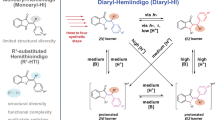Abstract
In search of strategies to operate photochromic compounds in aqueous environments, we synthesized two oxazines with a pendant oligo(ethylene glycol) chain each and a co-polymer with multiple oxazine and oligo(ethylene glycol) tails appended to a common macromolecular backbone. The hydrophilic character of the oligo(ethylene glycol) chains imposes solubility in water on two of the three systems. Their laser excitation in water opens the oxazine ring in less than 6 ns to generate zwitterionic isomers able to absorb in the visible region of the electromagnetic spectrum. The photogenerated species revert spontaneously back to the original forms with first-order kinetics. The transition from organic solvents to aqueous environments, however, causes a five-fold decrease in the quantum yield of the photoinduced ring-opening process and elongates the lifetime of the photogenerated isomer from the nanosecond to the microsecond domain. These hydrophilic and photochromic switches can be interconverted hundreds of times between their two states with no sign of degradation in water. As a result, our structural design for the realization of water-soluble photochromic compounds can lead to the development of viable strategies to modulate the structures and functions of biomolecules with microsecond switching times and excellent fatigue resistances under the influence of optical stimulation.
Similar content being viewed by others
Notes and References
G. H. Dorion and A. F. Wiebe, Photochromism, Focal Press, New York, 1970.
Photochromism, ed. G. H. Brown, Wiley, New York, 1971.
Organic Photochromes, ed. A. V. El’tsov, Consultants Bureau, New York, 1990.
Photochromism: Molecules and Systems, ed. H. Bouas-Laurent and H. Dürr, Elsevier, Amsterdam, 1990.
Organic Photochromic and Thermochromic Compounds, ed. J. C. Crano and R. Guglielmetti, Plenum Press, New York, vol. 1, 1999.
Applied Photochromic Polymer Systems, ed. C. B. McArdle, Blackie, Glasgow, 1992.
Photo-Reactive Materials for Ultrahigh Density Optical Memory, ed. M. Irie, Elsevier, Amsterdam, 1994
Chem. Rev., 2000, 100, pp. 1683–1890, issue on “Photochromism: Memories and Switches”, ed. M. Irie.
F. M. Raymo and M. Tomasulo, Chem.-Eur. J., 2006, 12, 3186–3193.
F. M. Raymo, Angew. Chem., Int. Ed., 2006, 45, 5249–5251.
J. Cusido, E. Deniz and F. M. Raymo, Eur. J. Org. Chem., 2009, 2031–2045.
I. Yildiz, E. Deniz and F. M. Raymo, Chem. Soc. Rev., 2009, 38, 1859–1867.
au]2_I. Willner and B. Willner, in Bioorganic Photochemistry, ed. H. Morrison, Wiley, New York, 1993, vol. 2, pp. 1–110.
I. Willner and S. Rubin, Angew. Chem., Int. Ed. Engl., 1996, 35, 367–385.
I. Willner, Acc. Chem. Res., 1997, 30, 347–356.
S. W. Hell, Nat. Biotechnol., 2003, 21, 1347–1355.
S. W. Hell, M. Dyba and S. Jakobs, Curr. Opin. Neurobiol., 2004, 14, 599–609.
S. W. Hell and L. Kastrup, Nachr. Chem., 2007, 55, 47–50.
S. W. Hell, Science, 2007, 316, 1153–1158.
S. W. Hell, Nat. Methods, 2009, 6, 24–32.
P. Gorostiza and E. Y. Isacoff, Science, 2008, 322, 395–399.
C. Dohno, S.-N. Uno and K. Nakatani, J. Am. Chem. Soc., 2007, 129, 11898–11899.
J. Andersson, S. Li, P. Lincoln and J. Andréasson, J. Am. Chem. Soc., 2008, 130, 11836–11837.
(a)R. C. Bertelson, in ref. 1, pp. 45-431; (b) R. C. Bertelson, in ref. 5, pp. 11-83.
A. S. Kholmanskii and K. M. Dyumanev, Russ. Chem. Rev., 1987, 56, 136–151.
R. Guglielmetti, in ref. 4, pp. 314-466 and pp. 855-878.
N. Tamai and H. Miyasaka, Chem. Rev., 2000, 100, 1875–1890.
V. I. Minkin, Chem. Rev., 2004, 104, 2751–2776.
M. Tomasulo, S. Sortino, A. J. P. White and F. M. Raymo, J. Org. Chem., 2005, 70, 8180–8189
M. Tomasulo, S. Sortino and F. M. Raymo, Org. Lett., 2005, 7, 1109–1112
M. Tomasulo, S. Sortino and F. M. Raymo, Asian Chem. Lett., 2007, 11, 219–222
M. Tomasulo, S. Sortino and F. M. Raymo, Adv. Mater., 2008, 20, 832–835
M. Tomasulo, S. Sortino and F. M. Raymo, J. Photochem. Photobiol., A, 2008, 200, 44–49
M. Tomasulo, S. Sortino and F. M. Raymo, J. Org. Chem., 2008, 73, 118–126
E. Deniz, M. Tomasulo, S. Sortino and F. M. Raymo, J. Phys. Chem. C, 2009, 113, 8491–8497
M. Åxman Petersen, E. Deniz, M. Brøndsted Nielsen, S. Sortino and F. M. Raymo, Eur. J. Org. Chem., 2009, 4333–4339; (i) M. Tomasulo, E. Deniz, T. Benelli, S. Sortino and F. M. Raymo, Adv. Funct. Mater. DOI: 10.1002/adfm.200901364.
M. Tomasulo, E. Deniz, R. J. Alvarado and F. M. Raymo, J. Phys. Chem. C, 2008, 112, 8038–8045.
B. S. Lele and M. G. Kulkarni, J. Appl. Polym. Sci., 1998, 70, 883–890.
Author information
Authors and Affiliations
Corresponding authors
Additional information
This paper is part of a themed issue on synthetic and natural photoswitches.
Rights and permissions
About this article
Cite this article
Tomasulo, M., Deniz, E., Sortino, S. et al. Hydrophilic and photochromic switches based on the opening and closing of [1,3]oxazine rings. Photochem Photobiol Sci 9, 136–140 (2010). https://doi.org/10.1039/b9pp00114j
Received:
Accepted:
Published:
Issue Date:
DOI: https://doi.org/10.1039/b9pp00114j




